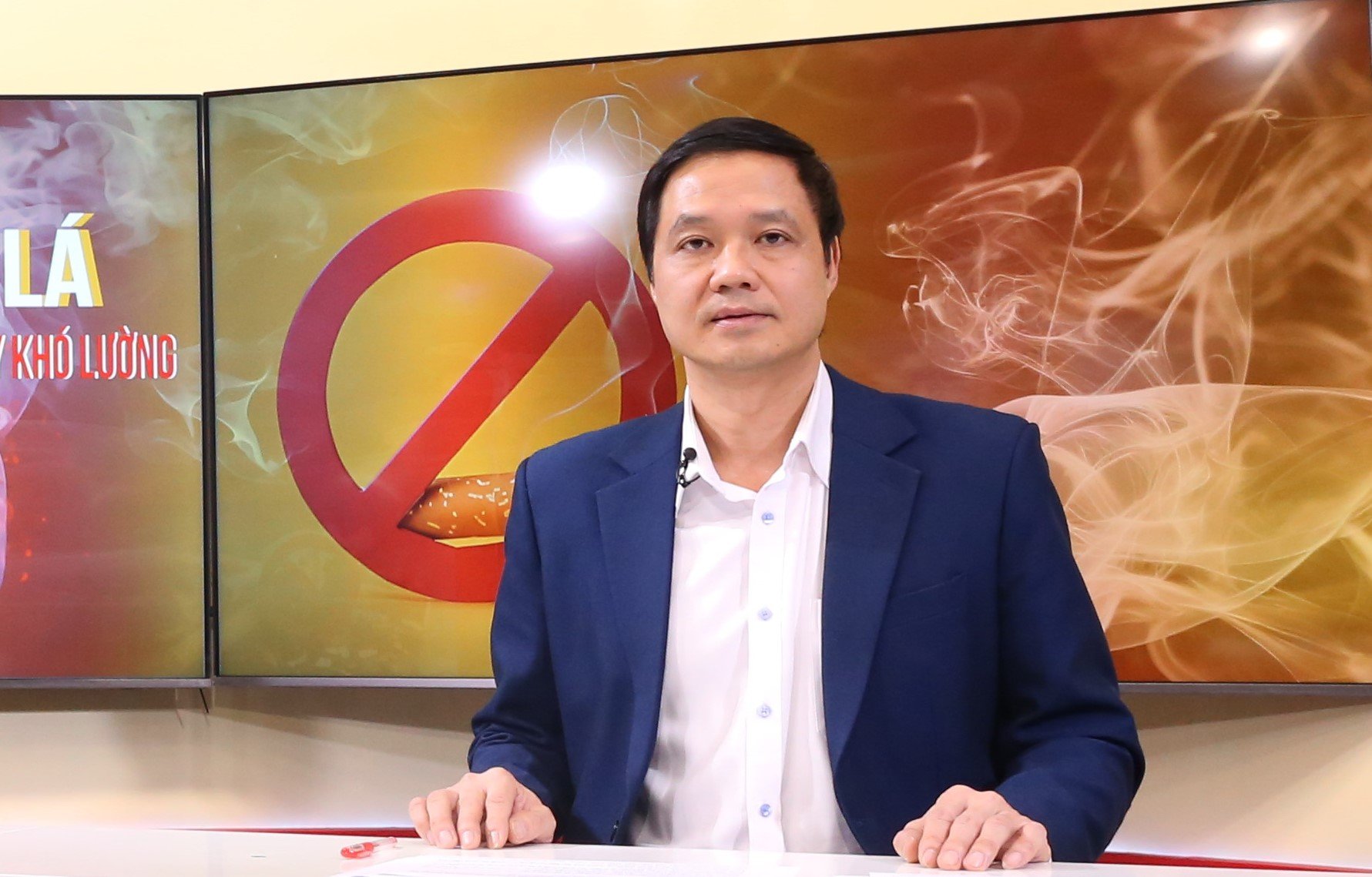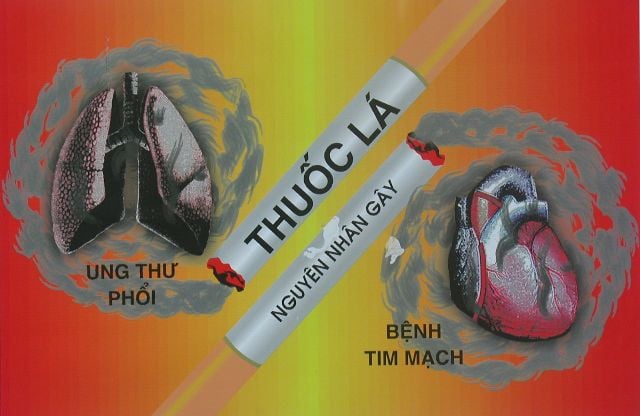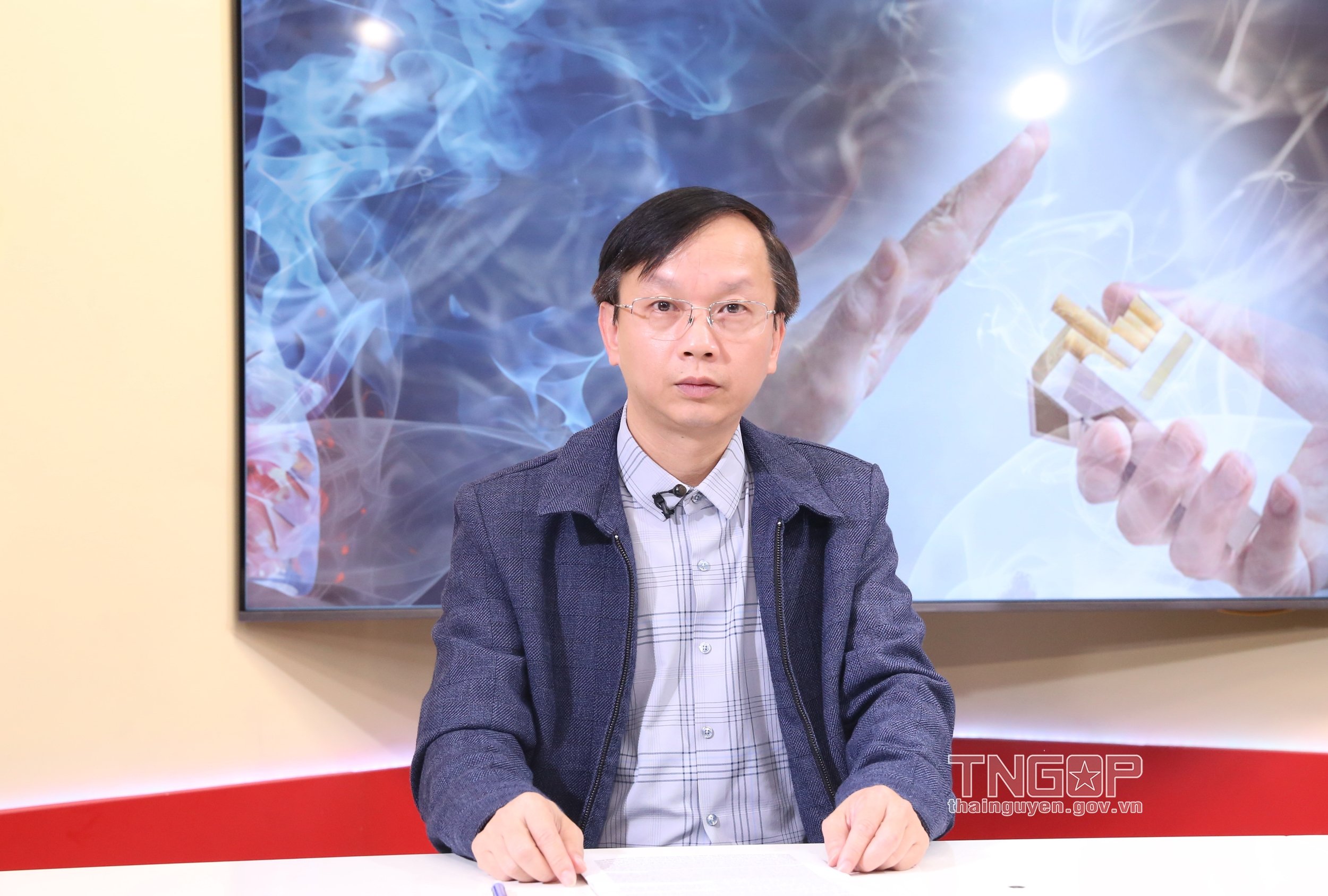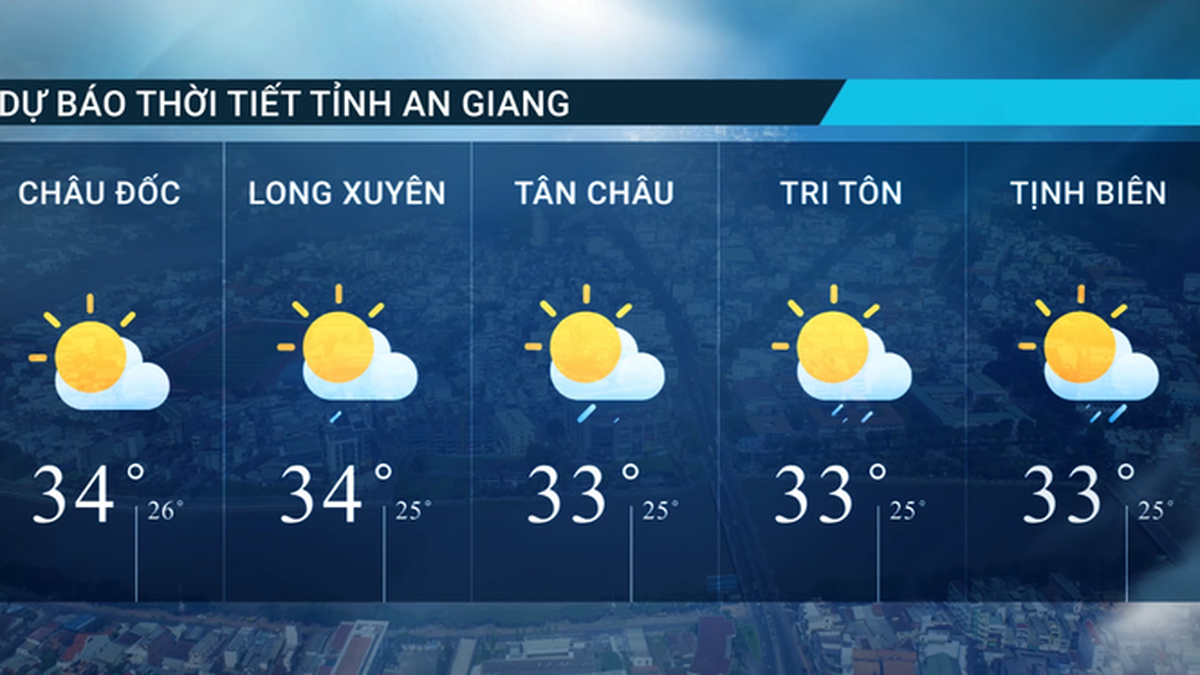MC Thanh Chung and guests
MC Thanh Chung: Ladies and gentlemen! Tobacco has caused consequences for human and community health, which many people are concerned about. Tobacco use is one of the habits that is very harmful to health and is the cause of many serious diseases. However, despite many warnings, even regulations and sanctions, the situation of tobacco use in Vietnam is still at an alarming level. To help you better understand the harmful effects and consequences of tobacco on human health, the Thai Nguyen Provincial Information Center organizes an online discussion program with the topic: Tobacco and its unpredictable consequences.
The program has the participation of 2 guests. We would like to respectfully introduce: Mr. Hoang Anh, Director of CDC Thai Nguyen; Mr. Vi Tran Doanh, Director of Oncology Center, Thai Nguyen Central Hospital.
Now let's watch the short clip we just made.
MC Thanh Chung: The clip just now showed us the dangers of cigarettes to human health. So what are the toxic substances in cigarettes and what are their effects on health, Mr. Hoang Anh?
Mr. Hoang Anh: Tobacco is a product made entirely or partly from tobacco ingredients, processed in the form of cigarettes, cigars, shredded tobacco, pipe tobacco or other forms. Tobacco use is the act of smoking, chewing, sniffing, inhaling, or sucking tobacco products.
Cigarettes contain over 7,000 chemicals that exist in two forms (particles and gases).
Small particles: Including addictive substances, typically nicotine and tar. The addictive properties of tobacco are classified by the US Food and Drug Administration (FDA) as similar to drugs, heroin and cocaine and brown mixtures containing substances such as benzene, benzopyrene... Many experiments on animals have proven that the particulate components of tobacco smoke are carcinogenic to the respiratory tract and other organs in the body.
Mr. Hoang Anh, Director of CDC Thai Nguyen
In gas form: Contains toxic substances: Carbon monoxide (CO), other toxic gases similar to the exhaust fumes of cars and motorbikes when they burn fuel.
On the harmful effects of cigarette smoke on human health:
Firstly, tobacco use is a major preventable cause of premature death and disease worldwide . Tobacco use is linked to many non-communicable diseases such as cardiovascular disease, cancer, chronic respiratory disease and gastrointestinal diseases. Worldwide , around 5.4 million people die each year from tobacco-related diseases – a figure that is expected to rise to more than 8 million per year by 2030. It is estimated that more than three-quarters of these deaths occur in poor or developing countries.
Every year in Vietnam, more than 40,000 people die from tobacco-related diseases. If Vietnam does not have effective measures to prevent the harmful effects of tobacco, this number will increase to 70,000 cases/year by 2030.
Second, smoking for cancer: Smoking is the cause of more than 90% of deaths from lung cancer. According to a survey at K Hospital in 2000, the rate of lung cancer patients who smoked was over 96%. In addition, smoking can lead to diseases such as laryngeal cancer; oral cancer; pharyngeal cancer in men.
Third, smoking has many harmful effects on respiratory diseases, which can be seen most clearly in the respiratory system: The relationship between smoking and chronic obstructive pulmonary disease is similar to the relationship between smoking and lung cancer. About 40% of patients with chronic lung disease (COPD) in developed countries are smokers or former smokers. Epidemiological studies show that smoking is associated with decreased lung function, increased incidence of acute respiratory infections such as pneumonia and influenza, and worsening of infections.
Cigarettes and their unpredictable effects
Smoking and cardiovascular disease: Scientific studies have shown a causal relationship between smoking and myocardial infarction. Compared to non-smokers, the risk of coronary artery disease is higher. In addition, smokers have a significantly increased risk of stroke.
Smoking and other health problems: Smoking reduces fertility in both men and women. In men, smoking reduces sperm count and changes sperm shape. Sperm shape changes can lead to miscarriage and birth defects. Scientists have also proven a causal relationship between smoking and female fertility. Smoking reduces female fertility; reduces menstrual cycles and affects the ability to conceive, increases the risk of ectopic pregnancy, premature birth or stillbirth.
MC Thanh Chung: Surely in the course of your work, Mr. Doanh has come into contact with many patients related to tobacco. So can you share more about the diseases that smokers often encounter?
Mr. Vi Tran Doanh, Director of Oncology Center, Thai Nguyen Central Hospital
Mr. Vi Tran Doanh: In Vietnam, lung cancer is the number one disease among the five most common cancers in both men and women. The cause of lung cancer is mentioned as tobacco (active and passive smoking). Tobacco causes 90% of lung cancer cases. This is proven by scientists and research. In Vietnam, research at the K Institute shows that the number is even higher (96 - 97%). In 1986, the International Agency for Research on Cancer, when studying the relationship between tobacco and cancer, concluded that smoking is the most prominent cause not only in some countries but worldwide. Not only active smoking but passive smoking also causes lung cancer in adults who have never smoked. Exposure to cigarette smoke at home or at work, with friends living in the same room increases the risk of lung cancer in non-smokers by 20 - 30%.
The risk of developing lung cancer also increases with the duration of smoking and the number of cigarettes smoked per day. There is no threshold for the risk of lung cancer from smoking. Other factors that may influence a smoker's likelihood of developing lung cancer include the age at which smoking began, the intensity of inhalation (deep or shallow, frequent or light inhalation), the nicotine and tar content of the tobacco, and the use of unfiltered cigarettes. The relative risk of developing lung cancer among smokers is 15 times greater than that among nonsmokers in general and 25 times greater for heavy smokers. The cumulative risk of lung cancer among heavy smokers can be as high as 30% compared with a risk of 1% or less among never smokers. Quitting smoking reduces the risk of developing lung cancer compared with continuing to smoke, and the risk decreases further the longer the period of abstinence. However, even after a long period of quitting, the risk of lung cancer in ex-smokers is still higher than in people who have never smoked.
Mobile vehicles and volunteers promote tobacco harm prevention on the streets of Thai Nguyen City.
MC Thanh Chung: In addition to the harmful effects on those who directly use cigarettes as you just shared, a question that many people are also interested in is, for those who do not smoke but inhale cigarette smoke, also known as passive smoking, what is the level of impact on health, Mr. Doanh?
Mr. Vi Tran Doanh: We know that smokers are not the only ones affected by cigarette smoke. Passive smokers are those who inhale the smoke and vapor exhaled by smokers, and secondly, they inhale the smoke from burning cigarettes directly released into the environment, which is a serious exposure risk to the health of non-smokers. In adults, passive smoking causes lung cancer (passive smoking increases the risk of lung cancer in non-smokers by 20-30%). In addition to lung cancer, passive smoking also causes breast cancer, cardiovascular diseases, peripheral atherosclerosis, coronary artery disease and is related to fertility issues. As Mr. Hoang Anh discussed in the beginning, non-smokers with high blood pressure or high blood cholesterol and passive smoking contribute to thousands of premature deaths from heart disease and cancer, especially lung cancer. Recent studies show that the risk of tobacco-related diseases is about 25 - 30% higher. And especially in children, exposure to cigarette smoke increases the risk of respiratory infections, otitis media, asthma, poor lung function development...
Teachers of Yen Lac Secondary School, Phu Luong district, propagate to students about the content "Building a smoke-free school"
MC Thanh Chung: Obviously, cigarettes contain many toxic substances, causing unpredictable consequences for health, even life. However, the reality is that cigarettes are still widely used in the community. So what is the cause of this situation, Mr. Hoang Anh?
Mr. Hoang Anh: First of all, it must be affirmed that tobacco is an addictive substance. The addictive substance in tobacco is nicotine, which is present in all types of tobacco products including: cigarettes, tobacco, cigars, pipes, self-rolled tobacco, smokeless tobacco, etc.
Tobacco addiction is a mental-physical state that occurs due to the interaction between the body and nicotine in cigarettes, manifested by the urge to smoke cigarettes continuously and regularly to achieve the pleasant feeling of smoking; at the same time, avoid the unpleasant feeling of not having cigarettes, the smoking behavior continues to be maintained even when the addict is fully aware of or even suffers from the harmful effects caused by cigarettes.
Another reason why cigarettes are widely used in the community is that: Cigarettes have been deeply ingrained in the subconscious of Vietnamese people from the 60s to the 70s. Since then, the following generations have also become familiar with cigarettes and consider it a normal and easy thing to encounter in life. Cigarettes in Vietnam are very cheap and especially other tobacco products such as tobacco can be grown for smoking and use. The problem of controlling smuggled cigarettes and the problem of checking and handling violations in places where smoking is prohibited have not been thoroughly implemented, leading to the situation of smoking in the community and public places still occurring widely and uncontrolled.
MC Thanh Chung: Dear 2 guests, Today's talk show with the topic of tobacco has received a lot of attention from readers. Through the Thai Nguyen Province Electronic Information Portal Fanpage, a reader with the Facebook nick Tran Anh sent the following question to the guests: Dear doctor, what phenomenon shows that a person is addicted to tobacco? And can tobacco addiction be cured? How to stop smoking and reduce cigarette cravings when deciding to quit? With this question, I would like to invite Mr. Doanh?
Mr. Vi Tran Doanh: To identify a smoker, the time of smoking a cigarette in the morning can also assess the level of nicotine addiction of a person. According to the Fagerstrom test for assessing nicotine dependence, if the first cigarette of the day is smoked within five minutes of waking up, the addiction is quite severe. If the first cigarette is smoked within 30 minutes, it is moderate, if it is smoked within 60 minutes or more, it is slightly lower. In addition, other signs that a person is addicted to tobacco include:
The number of cigarettes smoked each day increased, smoking longer and more than expected, spending a lot of time searching for and collecting cigarettes, always carrying cigarettes with you.
Smoking even when sick, continuing to smoke despite health problems, such as heart and lung disease.
Go outside to smoke even when it's cold or rainy.
Feel uncomfortable not smoking in places where it is prohibited (such as libraries, schools, cinemas or hospitals...). They cannot stay in those environments for long.
Continue smoking despite the advice or concerns of family or friends.
Another way to tell if someone is addicted to tobacco is when they try to stop and experience withdrawal symptoms, such as: Irritability, anger, feeling restless or having trouble concentrating, feeling like they have a mild flu, or headaches and dizziness.
About quitting smoking: Quitting smoking is possible. Nicotine withdrawal can be unpleasant for most smokers, but it is not physically dangerous. The unpleasant side effects of nicotine withdrawal are most severe when you first quit. They begin to lessen after a week and become even more severe after a month. Withdrawal symptoms may last longer, but they become easier to quit. Eventually, the time between cravings will get longer and longer, and with determination, you will eventually stop altogether.
Regarding effective ways to quit smoking, there are many ways so far such as:
Seek counseling: Talk to your doctor about nicotine replacement therapies, including over-the-counter options (nicotine gum, patches, and lozenges) as well as prescription medications such as Zyban (bupropion) and Chantix (varenicline).
People who want to quit smoking must be very persistent.
Try to find something else to do to forget about the cravings such as: Going for a walk, doing housework, calling a friend or playing with a pet, doing things that can help you forget about the cravings.
Eliminate cigarette odors in daily living areas such as: at home, at work, in clothes... to have a more attractive scent.
Remind yourself why you want to quit smoking, and give yourself a reward when you succeed. I think the greatest achievement is to bring health to your loved ones and those around you. They should think of the warning images on cigarette packs such as: images of terminal cancer patients; images of blackened, necrotic lungs...
Write a list of your top five reasons why you should stop smoking, such as not getting lung cancer or saving a significant amount of money each week by not buying cigarettes; reducing the negative feelings non-smokers have towards you...
Avoid temptations, such as seeing your partner smoke, feeling stressed, bored, or drinking. Know what situations make you most stressed and try to find coping techniques, such as deep breathing or practicing yoga or a certain sport.
Plan activities so you don't get bored. Avoid routines and temptations like I just mentioned.
Tell your family and friends that you are going to quit smoking so that they can understand and help you a lot in the process of quitting smoking. They can cheer you up to overcome the challenges of quitting smoking. The most important thing I want to say is that if we cannot quit, our health will be affected first, then our relatives, family, and friends.
MC Thanh Chung: We have just received a question from a reader with the email address hongduongtd@gmail.com sent to Mr. Hoang Anh as follows: Sir, does Thai Nguyen province have any model or network of smoking cessation counseling?
Mr. Hoang Anh: Since 2015, Thai Nguyen has implemented a model of counseling and support for smoking cessation at the Health Stations of communes in Pho Yen City. Up to now, medical staff of districts/cities and general and specialized hospitals at the provincial level are still being trained and updated on information on counseling and support for smoking cessation integrated into medical examination and treatment at the facility. Starting from 2024 and the following years, the health sector will conduct research to determine the need for counseling and support for smoking cessation for patients coming to visit and receive treatment at a number of provincial hospitals in the province. After the research, counseling and support for smoking cessation treatment will be implemented at the hospitals.
Continued update…
thainguyen.gov.vn
Source: https://thainguyen.gov.vn/vi_VN/thoi-su/-/asset_publisher/L0n17VJXU23O/content/toa-am-truc-tuyen-thuoc-la-va-nhung-he-luy-kho-luong?redirect=%2Fvi_VN%2Fthoi-su&inheritRedirect=true






































































































Comment (0)